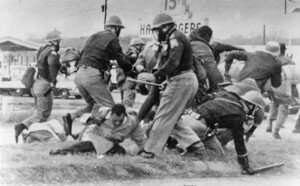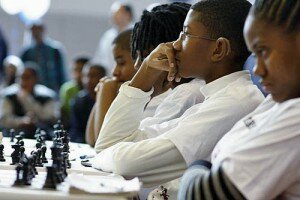The people or the pulpit
By Patricia Cunningham II, Graduate Associate, Office of Minority Affairs, The Ohio State University and William Sturkey, Gradute Teaching Assistant, Department of History, The Ohio State University
“Strong people don’t need strong leaders.” -Ella Baker
Historical Lens
Many of the most common scenes from the Civil Rights Movement misconstrue basic movement lessons. These images often depict a determined and vociferous Dr. Martin Luther King Jr. standing behind a pulpit, or behind a series of microphones, giving a rousing speech that would undoubtedly inspire his people to fight for their freedom. Other images might show King with his trusted aid and best friend, Ralph Abernathy, proudly leading a throng of blacks down a city street or country road to a courthouse, where King will inevitably lead his people in their demands for the right to vote. King is the era’s most striking symbol.
Montgomery bus boycotters, newspapermen, and thousands of civil rights activists, coupled with the bullet from James Earl Ray’s Remington Game Master, made him the movement’s most consummate martyr. But as Ella Baker once said, “The movement made Martin, and not Martin the movement.”
Baker was right. All of King’s success depended on strong grassroots leadership. After Rosa Parks was arrested on a Thursday afternoon, Montgomery’s Women’s Political Council (WPC) orchestrated a moonlit grassroots organizing effort that kept nearly 40,000 black riders off city buses the following Monday morning. It is common knowledge that the boycotters eventually won, but recent scholarship has shown a decline in Montgomery civil rights activities as local people became too reliant on leadership from the pulpit.
King nearly failed in Birmingham. At first, people did not want to march, and King’s now-famous “Project C” wavered for nearly two weeks. It was not until hundreds of youngsters were organized and trained in the tactics of nonviolence that the movement won a resounding victory.
Some of these images of King are of him and Abernathy dressed in their Sunday best, complete with flowered leis, leading blacks on a successful demonstration across Selma Alabama’s Edmund Pettis Bridge, where marchers had been severely beaten just two weeks earlier.

Then SNCC leader, now Congressman John Lewis led the first Selma-to-Montgomery march for voting rights on March 7, 1965, when 600 marchers were attacked by police in riot gear, who fractured Lewis’ skull on a day remembered as Bloody Sunday. Before going to the hospital, Lewis appeared before television cameras demanding intervention by President Johnson, who, eight days later, appeared before a joint session of Congress to demand passage of the Voting Rights Act. It was passed Aug. 3, 1965.
But King wasn’t at the original march when mounted patrolmen rode down nonviolent black protestors. Rather, workers from the Student Nonviolent Coordinating Committee (SNCC) had organized that community from the grassroots. They knocked on doors and held mass-meetings. That’s why the marchers came out. The attention from “Bloody Sunday” eventually attracted thousands of marchers from across America to the King-led demonstration two weeks later.
Despite the symbolic nature of King, the most important lessons of the civil rights movement should be taken from its most effective tactic: grassroots organizing. Leadership from the pulpit was always temporary. Empowering individuals and communities to fend for themselves offers more durability because local people have so much more invested in their own communities than a traveling preacher.
Commentators in “The Age of Obama,” have appropriately drawn consistent parallels to the civil rights movement. John Lewis, who led the original Selma march, stood next to Obama as America’s first black President was sworn into office on that blustery, historic January morning. Hundreds of movement veterans wrote essays, gave interviews, and offered testimonies that discussed how America used lessons from the civil rights movement to spring itself onto to this remarkable racial zenith. But now, as Obama receives attacks from the left and right for his policies, we are still forgetting the most important lessons from the civil rights era. After all, the people elected Obama, not Obama the people.
This presentation will begin to help recover those lessons. It will look at the Highlander Folk School, where both Baker and Parks received training, the Montgomery Bus Boycott, the influence of Baker on SNCC, the world renowned 1964 Mississippi Freedom Summer Schools, and grassroots organizing to elect Obama, to begin to recover the lost lessons from the movement and facilitate discussions of how they can be more aptly applied in the “Age of Obama.”
Current Context of the Activist
Today’s activist has much to learn from the past. What is compelling about the present is that most people live out their days almost in isolation of awareness from the richness of the roles and methods of historical activism. Compulsory education limits the expression and articulation of historical figures who were/are activists and there is a limited canon (MLK Jr, Malcolm X, Harriet Tubman, Frederick Douglass etc.) whose story gets told but it is not entirely. The role of activism is about community and collaboration. It is the collection of people making difficult choices despite adversity.
Most of the Civil Rights activists were advocating for radical reform in education, some of those reforms came by desegregation and access to higher education. Geoffrey Canada is an example of a contemporary leader who works quietly and diligently towards one goal: fighting poverty in Harlem by any means necessary. By Any Means Necessary is the same spirit as once voiced by Malcolm X but the methods are different. By asking what it would take to change the lives of poor children, Canada created the Harlem Children’s Zone (Tough, 2008). This innovation does not come from a place of newness.
In fact during the 1950’s and 1960’s there began a historical narrative of neighborhood based anti-poverty strategies and programs. What this program focused on differently than its predecessors was that it focused on education as the key component and then everything else is built around that. What Canada found was that education had to be a support net that started earlier than compulsory education. The emotional, medical, and educational support must begin before a student gets to high school.
The obstacles that keep students in urban areas from graduating from college are more complex than just addressing schooling. There are a host of non-cognitive factors that also have to be addressed. The activism that needs to clearly be present know when it comes to education and/or dealing with children is that this investment must take into account these non-cognitive factors such as home environment, teacher and peer expectations, social isolation, students’ perception, racial identity issues, and environmental stressors that come with living in different kinds of communities (Hood, 1992).
Activism must become a community effort, once again. The isolation or liberal individualism that black people are adhering to is hurting the future of students coming from black communities. This is another lesson that needs to be shared and replicated. Harlem Children’s Zone is one of those unique examples that demonstrates current activism that emulates what Civil Rights’ activists got right, and that is making hard choices, building community on purpose, and economically, politically and emotionally investing in children changes the future and inspires hope.
Hood, D. W.. (1992). Academic and noncognitive factors affecting the retention of black men at a predominantly white university. The Journal of Negro Education, 61 (1), 12-23.
Tough, P. (2008). Whatever it takes. First Mariner Books: New York.
STRONG PEOPLE DON’T NEED STRONG LEADERS: APPLYING THE FINEST EXAMPLES OF HISTORICAL GRASSROOTS LEADERSHIP TRAINING IN THE AGE OF OBAMA
Friday, March 12 at the Transforming Race Conference from 11:00 a.m. - 12:15 p.m.
 Patricia Cunningham II, Graduate Associate, Office of Minority Affairs, The Ohio State University
Patricia Cunningham II, Graduate Associate, Office of Minority Affairs, The Ohio State University
 William Sturkey, Gradute Teaching Assistant, Department of History, The Ohio State University
William Sturkey, Gradute Teaching Assistant, Department of History, The Ohio State University
Author: Kirwan Institute (427 Articles)

Most Recent
Recent Comments
- Blog News- Left and Right Views » Race-Talk » Blog Archive » Michael Barone gets his facts wrong on Michael Barone gets his facts wrong
- Acknowledging Difference, not Defeat: A Racial Justice Perspective on the Medicaid Debate | health justice NYC on Acknowledging difference, not defeat
- Links of Great Interest: Bring Amina home! — The Hathor Legacy on In prison reform, money trumps civil rights
- Race-Talk » Blog Archive » President Barack Obama, Dred Scott: A … | Barack Obama on President Barack Obama, Dred Scott: A case of domestic terrorism
- In prison reform, money trumps civil rights « Politicore on In prison reform, money trumps civil rights
Search in Archive
Favorite Blogs
What is Race-Talk?
The Race-Talk is managed and moderated by the staff at the Kirwan Institute for the Study of Race and Ethnicity and is open to all respectful participants. The opinions posted here do not necessarily represent the views of the Kirwan Institute or the Ohio State University.
Our goal is to revolutionize thought, communication and activism related to race, gender and equality. Race-Talk has recruited more than 30 extraordinary authors, advocates, social justice leaders, journalists and researchers who graciously volunteered their expertise, their passion and time to deliberately discuss race, gender and equity issues in the US and globally.



COMMENTS